
Are you coaching soccer for the first time? Or an experienced coach looking for new ways to motivate your team and change things up a bit?
Either way, as a youth soccer coach you need some passing drills to use during practice and in pregame warmups. Passing drills are a great way to encourage teamwork and are critical for players of all skill levels.
Ahead, you’ll learn a few main areas to focus on in your drills and some quick examples you can try at your next youth soccer practice.

The best soccer passing drills for your team
1. Pass and Move
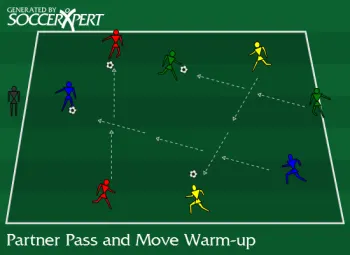
Source: SoccerXpert
Set Up: Divide your team into pairs. Each pair gets a ball. Players should start about 10-15 yards apart.
How it works: Player A passes the ball to Player B and immediately starts moving to a new open space. Player B then returns the pass to Player A in their new location. Repeat this sequence for several minutes, encouraging quick, accurate passing and constant movement.
Purpose: This drill encourages players to think about space, helps them understand the importance of constant movement during a soccer game, and builds their passing accuracy and speed. It's a foundation for dynamic gameplay where possession is key.
2. Triangle passing
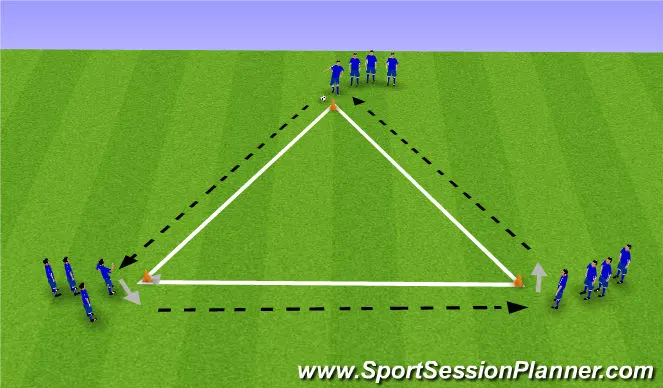
Source: Sport Session Planner
Set Up: Split your team into groups of three, forming a triangle with each group. Each group gets a ball.
How it works: Players pass the ball to each other following a specific order, either clockwise or counter-clockwise. Encourage one-touch passes and proper receiving techniques. After a while, you can increase the difficulty by enlarging the triangle or introducing a defender.
Purpose: This drill improves passing and receiving skills, allows players to practice passing at different angles, and promotes communication and teamwork.
3. Wall passing or One-Two passing combination
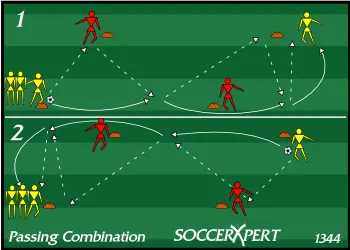
Source: SoccerXpert
Set Up: Split your players into pairs, each pair with one ball, starting about 5-10 yards apart.
How it works: Player A passes to Player B, who immediately returns the ball (acting like a "wall"). Player A must control the returned pass, and the sequence repeats. Swap roles after a few minutes so both players get to be the 'wall.'
Purpose: This drill is excellent for teaching quick one-two passing, improving first touch control, and developing speed of play.
4. Square drill
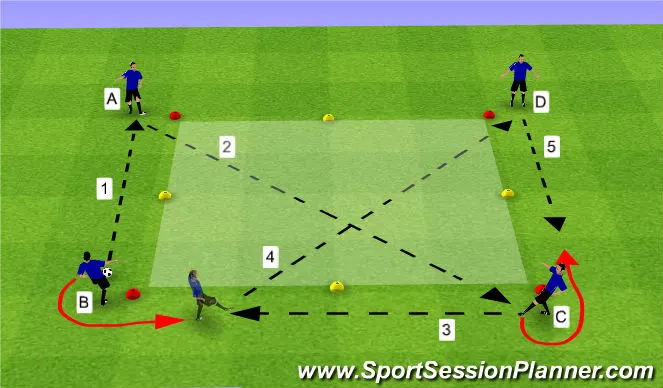
Source: Sports Session Planner
Set Up: Form a square with four cones. Each side of the square should be about 10 yards. Form groups of four players, each player standing on a cone.
How it works: Player A passes to Player B and then runs towards Player B's position. Player B passes to Player C and runs towards Player C's position, and so on. The sequence should follow a pass and follow pattern.
Purpose: This drill develops spatial awareness, anticipation, and communication among players while enhancing their passing and receiving skills. It also encourages players to keep their heads up and scan the field.
5. Passing gates
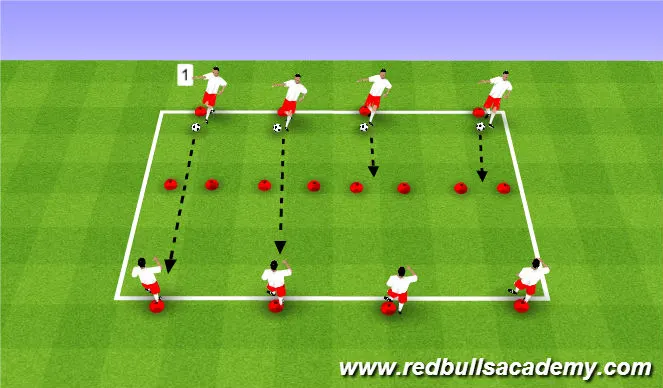
Source: Sports Session Planner
Set Up: Set up several small gates (two cones about 2 yards apart) randomly around the field. Split your players into pairs and give each pair a ball.
How it works: The pairs pass the ball to each other through the gates. Each successful pass through a gate scores a point. Run the drill for a set time and see which pair scores the most points.
Purpose: This drill encourages accurate passing and receiving under a bit of pressure. It also helps players develop their spatial awareness and decision-making skills as they have to choose the best gate to pass through.
📚 Learn: How to Make a Youth Soccer Website
6. Long passing drill

Source: Sport Session Planner
Set Up: Two players stand a significant distance apart (30-40 yards). Each pair has one ball.
How it works: Players try to make long passes to each other. Encourage players to use both feet and different passing techniques. The players should control the incoming ball before making their own pass.
Purpose: This drill helps develop long pass skills, including accuracy, strength, and timing. It's particularly useful for players who need to send long, cross-field passes during games.
7. Crossing and finishing drill
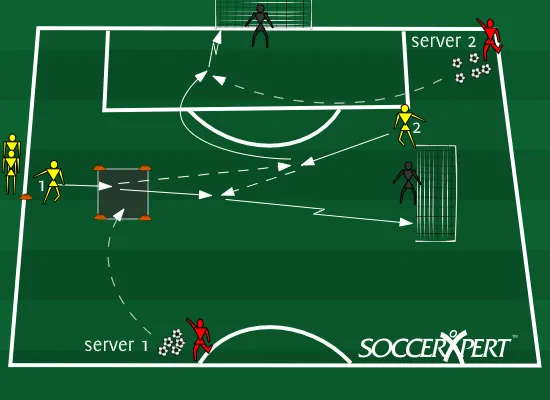
Source: SoccerXpert
Set Up: Split your team into groups of three - one crosser, one attacker, and one goalkeeper. The crosser starts wide near the sideline with a ball, the attacker is near the penalty area, and the goalkeeper is in the goal.
How it works: The crosser sends the ball into the box, aiming for the attacker, who tries to score with one touch. Rotate roles every few minutes so each player gets a chance to cross, finish, and defend.
Purpose: This drill helps improve crossing accuracy, finishing skills, and goalkeeping. It's a good simulation of game situations and encourages quick decision-making and execution.
8. Passing relay race

Source: Competitor Spot
Set Up: Divide players into even teams and have them line up with each team having a ball at the front of the line.
How it works: The first player in line passes the ball to the second, who passes it to the third, and so on. The ball should be passed along the line and then back. The first team to complete this without losing control of the ball wins.
Purpose: This competitive drill encourages fast, accurate passing and dribbling under pressure. It also fosters teamwork and communication as players must work together to win.
9. Diamond passing drill
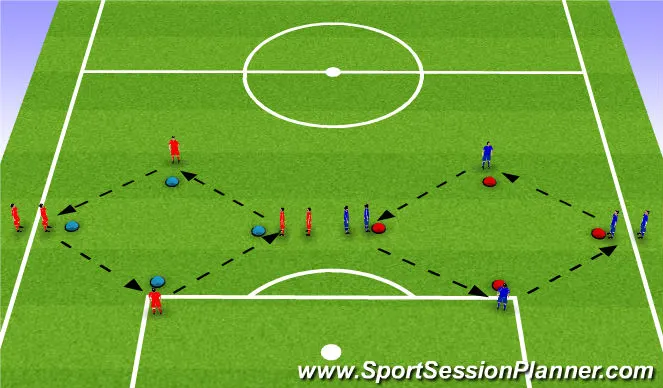
Source: Sports Session Planner
Set Up: Four players are positioned in a diamond formation. One ball is needed for this drill.
How it works: The ball starts with one player who passes to the player at the next point of the diamond. This player, upon receiving the pass, should turn and pass it to the next player. Players should always follow their pass to the next point in the diamond. Encourage players to communicate, move quickly, and use one-touch passing when possible.
Purpose: This drill helps teach advanced passing skills and concepts like checking the shoulder, opening the body, and playing a one-touch pass. It also improves players' awareness, footwork, and decision-making skills.
10. 4 vs 1 Rondo

Source: SoccerXpert
Set Up: For this drill, you need five players and one ball. Set up a grid of about 10 x 10 yards (you can adjust the size as needed). Four players position themselves on the corners of the square, and one player (the defender) stands in the middle.
How It Works: The four players on the outside of the grid aim to keep possession of the ball by passing amongst themselves while the defender in the middle attempts to intercept or gain control of the ball. The outside players should move along the line of their square to support the player with the ball. If the defender intercepts the ball, they swap places with the player who lost possession.
Purpose: The 4 vs. 1 Rondo drill is designed to improve players' passing and receiving skills under pressure. It also promotes quick decision-making, improves ball control, and enhances players' ability to keep possession. The drill emphasizes the importance of accurate and timely passing, spatial awareness, and effective communication between teammates.
Coaching points for running youth soccer drills
Choose simple, fun drills
Don't waste half of your practice trying to teach players how to do a drill. Make sure you're picking simple drills that match the skill levels of your players.
Players should be able to understand a new drill with one quick demonstration. If you have to explain how to do the drill every week, or players are constantly misinterpreting instructions, you need to move on to a new drill.
And drills need to be fun to be effective. You should never hear a player groan or sigh when you announce it's time for a drill. If players are frustrated to do drills, it's not because they aren't hard workers - it's because your drills are too boring.
Seeing your players make progress is one of the top benefits of coaching youth sports. Your players will pay attention and learn quickly if you find drills that are fun.
Change up drills often
Routine is important, and players should know what to expect when they arrive at practice. Use the same rough practice plan each week. For example a 1 hour and 30 minute practice can look like:
- 10 minute warm up
- 20 minutes of drills
- 15 minutes of instruction based on recent games
- 5 minute break for water
- 30 minutes of fun games or a scrimmage
- 10 minute practice recap and cool down
But, you need to change things up throughout your season to keep young players engaged. Finding drills that you can build upon will give players the routine they need while also challenging them.
Each drill below has several variations you can use throughout your season so that players are constantly learning. Try at least two different drills per practice for about 10 minutes each. If you have a list of 4 or 5 go-to drills that all of your players know, with several variations for each drill, you'll be able to make each drill session challenging and unique.
Make the drills competitive
One of the keys to coaching youth sports is finding the right balance between learning, fun, and competition.
Training sessions should be challenging and include friendly competition. Reward players who complete the passing and shooting drills with picking the game at the end of practice, choosing the next drill, or even deciding your next post-game event.
You can also challenge the entire team to repeat the passing game successfully 10 consecutive times. If the team meets expectations during the drill you can cancel any typical end of practice conditioning drills.
If you're doing a drill that involves teams, think through how you want the teams to be structured before practice begins so the teams are somewhat even. Younger players can tend to be cliquey - as the coach you need to be decisive picking the teams if you want competition to be fair.
⚡Interested in starting a new soccer organization in your community? Learn how to get started in our posts:
Get lots of soccer balls
What are the most important skills to teach youth soccer players? Constant movement and the fundamentals of kicking the ball. If your players are standing still during warm up drills, you're doing it all wrong!
If you only have 1-2 hours for practice, make sure your players are moving at all times and consistently have a ball at their feet.
You'll need at least one ball for every two players. Ideally, each player brings their own ball to practice so there are more than enough balls for every drill.
Once you have your basic practice schedule outlined you can choose a few drills to try at your first practice. If you need money to get more soccer balls, try these top soccer fundraising ideas today.
Take your soccer training to the next level this season
Get together an email chain with your coaching staff and agree upon a few different training drills you can do consistently with your players. Player attention spans can be short, so you should rotate through several drills for 5-10 minutes each practice.
Sticking with a similar routine will help your players continue to improve. But mixing in a bit of fun and constantly keeping players in motion is critical if you want to keep them from becoming bored.
Soccer passing drills FAQ
What is the 1 and 2 touch passing drill?
The 1 and 2 touch passing drill in soccer involves players working in pairs or small groups, passing the ball using only one or two touches. One-touch passing requires players to pass the ball back immediately upon receiving it. Two-touch passing requires them to control the ball first (first touch) and then pass it (second touch).
What is the circle passing drill in soccer?
The circle passing drill in soccer involves players standing in a circle, passing the ball to each other while maintaining their positions. This drill enhances players' ability to pass and receive the ball from different angles. You can introduce variations, such as one-touch passes, two-touch passes, or adding a defender in the middle.
How do I get my soccer team to pass the ball?
One big issue in youth sports is getting kids to participate. To encourage your soccer team to pass the ball, first ensure they understand the importance of passing in maintaining possession and creating scoring opportunities. Implement various passing drills during practice to improve their soccer skills. In addition, promote a team-oriented mindset, where players recognize that successful passing plays are often more effective than individual efforts.
How to do passing drills in soccer?
To do passing drills in soccer, start by setting clear objectives, such as improving accuracy, speed, or communication. Depending on the drill, you may need cones to mark areas or create 'gates.' Divide players into pairs or small groups, explain the drill, and demonstrate if necessary. During the drill, provide constructive feedback and gradually increase the difficulty to challenge the players and keep them engaged.